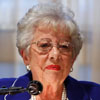Former USC Law Dean Dorothy W. Nelson presents Roth Lecture
On an occasion that marked the 40th anniversary of her installment as dean of USC Gould School of Law, the Honorable Dorothy W. Nelson presented the 2009 Justice Lester W. Roth Lecture Oct. 13.
Nelson, a pioneer in advocating for mediation and arbitration, addressed the transcendent norms needed to achieve justice in the world, and the role alternative dispute resolution – or “appropriate” dispute resolution, as she calls it – can play in resolving conflict.
“Justice, to me, means to consider the welfare of the community as one’s own,” Nelson said. “It means to regard humanity as a single individual and as one’s own self as a member of the corporeal form and to know of a certainty that if pain or injury afflicts any member of that body, it must inevitably result in suffering for all the rest.”
Among the norms that must be recognized before justice can be achieved in society are the need for universal education, the abolition of racism; the abolition of the disparity between rich and poor; and the recognition of the equality of women and men, Nelson said.
Nelson in 1957 became the first woman to hold a full-time faculty position at USC Law and was an early proponent of teaching mediation. She served as dean from 1968 until 1980, when she was appointed to the United States Court of Appeals for the Ninth Circuit and started the first court mediation program in the state.
“After 30 years on the bench, I’m convinced that a decisive moment is at hand for our court system,” she said. “The use of mediation and other forms of appropriate dispute resolution show great promise and may alleviate the need for vast numbers of new judges and vast numbers of new courthouses.”
“Our system is too costly, too painful, too destructive, too inefficient for a truly civilized society.”
In an adversarial system like that in the United States, vested interests are pitted against each other until there are definitive winners and losers. Mediation is a way of allowing both sides to have their points of view acknowledged and come to a creative, collaborative solution that not only solves the current conflict but sets the groundwork for resolving future conflicts, Nelson said.
When Nelson joined the bench, she was amazed there was no mediation program in place. Since then, the Ninth Circuit has developed and expanded its mediation program to a staff of 10 full-time mediators. Out of the circuit’s 15,000 cases each year, mediators handle close to 1,000, with an 85 percent success rate in which parties come up with their own solution, Nelson said.
While the court benefits from reduced costs and delays thanks to the efficiency of mediation, its purpose should not be defined as permitting courts to unburden themselves of unwanted cases, Nelson said.
“Its purpose is not to make life easier for judges and administrators by eliminating cases, but rather to gain respect for the courts by providing dispute resolution tools that really give the parties an opportunity, successful or not, to try to resolve their problems with some help from a neutral third party provided by the court,” she said.
Law schools like USC need to promote problem-solving learning and teach students that there are usually numerous “right” answers to a problem, even if the outcome is relatively certain. Schools should follow USC Law’s lead in providing academic courses and clinics that promote negotiation, mediation and collaborative processes, Nelson said. USC Law offers both an upper-level course on mediation and negotiation and a semester-long clinic in which students mediate six or more Los Angeles County Superior Court cases.
“We need to build on this work and explore how good dispute resolution and problem-solving skills can take the lawyer’s role as process architect to new levels of innovation that will at times involve non-lawyers as well,” Nelson said. “We need to develop new processes and more creative solutions with more heads and hearts at the table.”
-Story by Lori Craig. Photos by Steve Cohn.

















